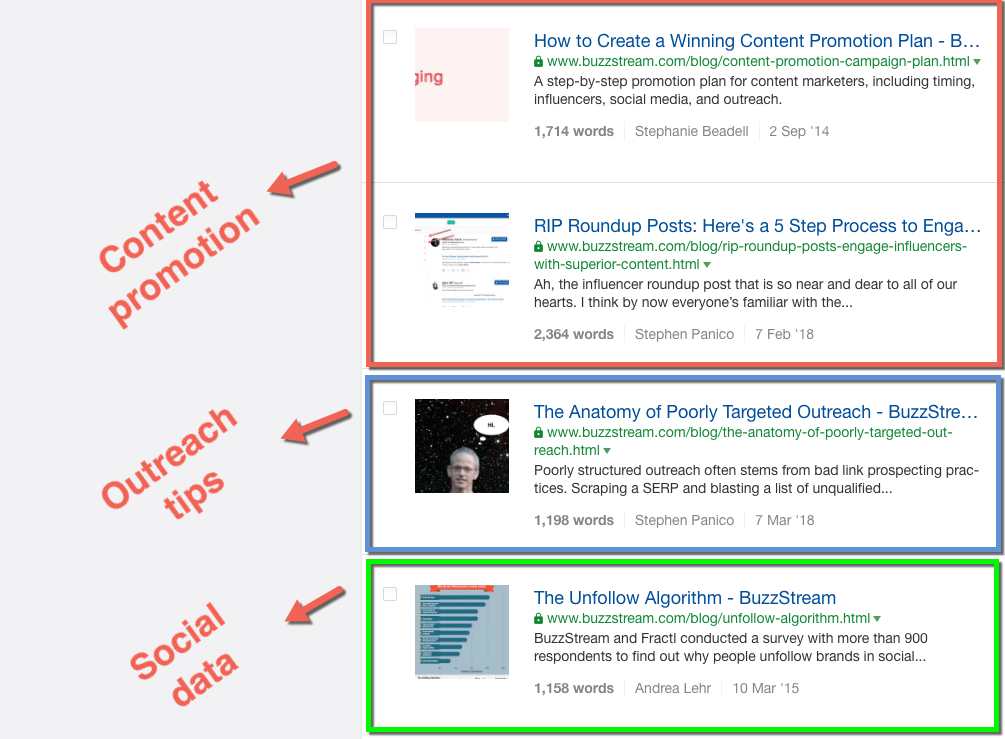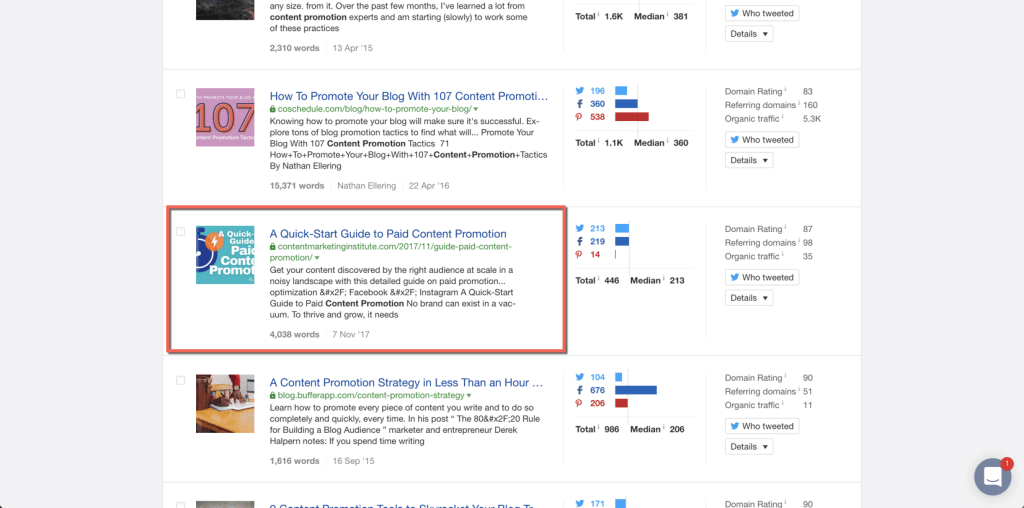Table of Contents
If you’ve been writing content for a significant amount of time, you know that consistently identifying high value topics can get very difficult.
In fact, once you’ve built up a decently sized content catalog it may feel like you’ve already covered all the ground possible. Combine that with everyone throwing out content, and it can feel impossible to say anything new.
However, that very backlog and oversaturation can be remarkably effective in helping you generate unique content that will resonate with readers in your niche.
In this article, I’m going to show you how to triangulate your top performing content, popular angles in your niche, and underexplored areas of interest to generate truly unique content. Let’s get started.
Identify the topics that resonates with your audience
The first step in this process is identifying which topics already resonate well with your audience. You’ve probably heard that the greatest predictor of future success is past success, and that applies as much to content as anything else.
If you are hesitant to cover the same ground that you’ve already touched on in the past, don’t worry too much. Before the end of this process we’ll ensure you’re taking a fresh approach to the topic.
In order to determine the topics which resonate best, I’d recommend confirming it based on your goals. For the purposes of this article, let’s say we care most about amplifying our message through social engagement.
1. Log in to Ahrefs and navigate to the content explorer tool.

2. Set the date window you care about. In most cases with content analysis I tend to look at the past year, but in this case I want to look at all the content we’ve posted then manually review the topics and dates. That will give me a good idea of whether the content has consistently appealed to our audience long term.

3. Now enter the URL for your blog or website (or that of your clients) and sort by the metrics that apply to your content goals. In this case we’re sorting by total shares.

4. Now look at your top performing content and group the recurring topics. In this case, you can see that in our top five results we’ve got two articles focused on content promotion, one on outreach tips and another on social data analysis.

- Once you’ve grouped all of your topics, make note of the top content area that has most consistently appealed to your audience.
Find the top content trends in your chosen topic area
Once you’ve identified the top performing content for your audience, you need to identify what is currently resonating in that topical niche overall. This will allow you to take the pulse of the current landscape to get a sense of the specific subtopics and points of interest that you should be trying to cover in your new content.
There are many tools you can use to discover this, but here’s a simple process you can use in Ahrefs since we’re already hanging out there.
1. Once again, navigate to the Ahrefs content explorer and plug in the topic category that you discovered as being most performant for your audience. This time, you will want to apply some filters to make sure you’re looking at high quality content.
The specifics will change slightly for your use case, but I’d recommend starting with something similar to these:
- Set publish date to past year
- Change the relevant language to English (or whichever most fits your market)
- Set the domain rating to a minimum of 15
- Set total shares (or shares on your most important network) to a minimum of 50
- Set referring domains to a minimum of 10

2. Look through the content and identify any specific subtopics that seem to be popular and add them to a list. Sometimes you can grab these straight from the headline, as with this example for “paid content promotion”. Other times, you’ll need to dive into the popular content to find the unique angle.

3. Now, identify a subtopic from your list that you think would resonate with your audience and review the content. What you’re looking for are specific elements of the content that have a lot of potential interest but are briefly explored or largely unanswered.
In this case, the mention of Instagram paid content promotion serves the purposes of the article but there is a LOT more you could cover on this topic!

4. Continue doing this until you’ve accumulated enough to get a good idea of the areas of opportunity within your selected subtopic.

***A Brief Caveat***
As I mentioned, this is a simple and direct process. However, it can pick up some results that perform well simply because the sites they are posted on are popular and will get promoted no matter what. If you want a slightly more involved process that will correct for this, I’d recommend you check out Derek Gleason’s guide to adding more context to your content analysis.
Understand the questions people have about these opportunities
Now that you understand the resonant subtopics and underexplored areas of interest you’ll need to validate that these are areas that readers are actually interested in. What you’re looking for here are high interest questions that have not been satisfactorily answered.
You can find these on the main Q&A sites like Quora or specific subreddits, but BuzzSumo has put together a tool specifically geared towards finding questions and organizing them by topic.
1. Log in to BuzzSumo and navigate to their Question Analyzer. Plug in your specific interest areas. Note: you’re probably going to have to play with the language a little bit until you hit on the wording that gets you a substantial number of results.

2. BuzzSumo will now return a list of questions organized by topic and a word cloud that will highlight the biggest topic categories and let you jump right to the ones that interest you.

3. Now begin exploring the questions around your chosen topic. Pay particular attention to the questions on larger sites (Quora and Reddit) because they will often get more exposure than those on niche forums.

4. Once you find a question that seems applicable, open it up and gather some more info. Ideally, you want a question with lots of interest (follows or upvotes) but very few answers or ones that don’t answer it satisfactorily. That will indicate that this is a hot topic without great info currently – a perfect opportunity for you to dive in.

5. Other opportunities you can look for are questions that have a large number of self-promotional answers. These will often answer the question in a cursory way but drive people to a paid consultation for the real info. If somebody is getting paid for info there’s likely a lot of interest.

6. If others are giving responses to question that seem good but don’t answer it comprehensively, make a note of those as well. You can expand on them in your piece. Also, you can reference the original response for a great opportunity to build a relationship.

Identify where you can uniquely add value to the conversation
At this point you’ve got a list of specific topics that you know are highly in demand and will resonate with your audience and your vertical once you hit that publish button. The last step to determining which of these is the best fit (or which you should prioritize first) is to figure out where you can add unique value.
When you create content that is genuinely hard for others to replicate you have a greater chance for it to spread due to its originality and it will appeal more to high authority sites. It also creates a competitive advantage for your content because no one will be able to swoop in and create something that is 10x better without major effort.
The specific unique value that you can add will vary quite a bit, but it will almost always fall within one of these categories:
- Unique expertise – you do this professionally and have direct specialized knowledge
- Access to influencer expertise – you’ve got good relationships with people you can collaborate with who have deep knowledge around this topic
- Illustrative case studies – you or your clients have demonstrated, with data to back it up, that you know how to respond to this topic
- Access to proprietary data – you’ve got access to unique data that you own that can answer key points within this topic
- Survey information – you’ve taken the time to gather statistically representative results that do a great job of illuminating the topic
- Deep research – you know how to access information that is highly technical, industry specific, or hidden (through out of print works, interviews, etc.) and can translate it to readers
In any case, carefully review your list and note where you’ve got the opportunity to add unique expertise. Don’t skimp on this step. It’s worth engaging with other teams in your organization or reaching out to influencers to get a sense of true competitive advantage opportunities.
Now write!
At this point you’ve got all the pieces in place, so get out there and write! The good news is, given the way that this process uncovers highly unique opportunities that aren’t unanswered, you can utilize it again and again to fill out your editorial calendar.
If you decide to use this process, I’d love to hear from you. Do you have other ways you’re creating fresh content?

 Check out the BuzzStream Podcast
Check out the BuzzStream Podcast



1 comment
There are so many saturated markets to target now, you couldn’t be more correct on that point. We have found the same with our affiliate website that we manage, it is difficult finding good products and services to talk about that haven’t already been covered by other companies. Looking forward to the next post that you put out Stephen.